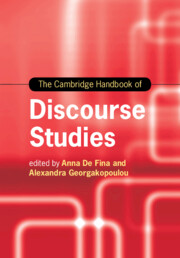Book contents
- The Cambridge Handbook of Discourse Studies
- Cambridge Handbooks in Language and Linguistics
- The Cambridge Handbook of Discourse Studies
- Copyright page
- Contents
- Figures
- Tables
- Contributors
- Preface
- Part I (Con)Textualizing Discourses
- Part II Perspectives and Modes of Analysis
- Part III Discourse Materialities and Embodiment
- Part IV (Trans)Locations and Intersections
- Part V Ethics, Inequality and Inclusion
- 21 Ethics and the Study of Discourse
- 22 Migrants, Citizenship and Language Rights
- 23 Diversity and Inclusion in Education
- 24 Discourse and Racialization
- 25 Discourse and Narrative in Legal Settings: The Political Asylum Process
- 26 Discourse and Religion in Educational Practice
- Part VI Discourses, Publics and Mediatization
- Index
- References
25 - Discourse and Narrative in Legal Settings: The Political Asylum Process
from Part V - Ethics, Inequality and Inclusion
Published online by Cambridge University Press: 28 September 2020
- The Cambridge Handbook of Discourse Studies
- Cambridge Handbooks in Language and Linguistics
- The Cambridge Handbook of Discourse Studies
- Copyright page
- Contents
- Figures
- Tables
- Contributors
- Preface
- Part I (Con)Textualizing Discourses
- Part II Perspectives and Modes of Analysis
- Part III Discourse Materialities and Embodiment
- Part IV (Trans)Locations and Intersections
- Part V Ethics, Inequality and Inclusion
- 21 Ethics and the Study of Discourse
- 22 Migrants, Citizenship and Language Rights
- 23 Diversity and Inclusion in Education
- 24 Discourse and Racialization
- 25 Discourse and Narrative in Legal Settings: The Political Asylum Process
- 26 Discourse and Religion in Educational Practice
- Part VI Discourses, Publics and Mediatization
- Index
- References
Summary
Legal assessments of whether applicants qualify for political asylum in a country of refuge rely primarily on the applicants’ narratives and on their answers to questions posed by immigration officials during a face-to-face hearing. It is incumbent upon the applicants to attempt to persuade the officials of their credibility and of the merits of their case. In their assessments, the officials take into account the applicant’s demeanor, ability to recount a coherent narrative, and other often unarticulated measures of credibility. Lacking other evidence, or in the face of disputed identity documents, assessments of discourse are central to political asylum decisions. This chapter reviews what is now substantial research on the role of discourse in political asylum hearings and decisions. It considers how mistranslation and the failure to determine an applicant’s dialect have resulted in significant mistakes. It reviews the scholarship on demeanor and reported speech acts (e.g. bribery and threats). Our primary focus is on the dimensions of narrative in the political asylum process. We begin with the largest issues posed by the narration of trauma; the difficulties faced by people who have suffered atrocities are sometimes so beyond comprehension that they escape memory and narrative. In a close examination of narrative form and structure, we discuss how narrative fails in the asylum process, for example in misplaced orienting details, in the use of repetition, in attention to what the officials regard as extraneous information, in what is omitted (especially during accounts of rape) or in accounts that appear to be memorized or that contain stock elements that have become too familiar to the officials. Our discussion of narrative attends to the ways in which discourses are evaluated as too familiar or too strange. Finally, we consider the significant roles played by discourse analysts in the political asylum process.
- Type
- Chapter
- Information
- The Cambridge Handbook of Discourse Studies , pp. 547 - 570Publisher: Cambridge University PressPrint publication year: 2020
References
Further Reading
This volume provides global perspectives on the laws and policies of political asylum.
This volume remains a foundational study on the ways in which narratives function in legal settings.
This is an important study of the gendered dimension of asylum.
References
- 1
- Cited by

